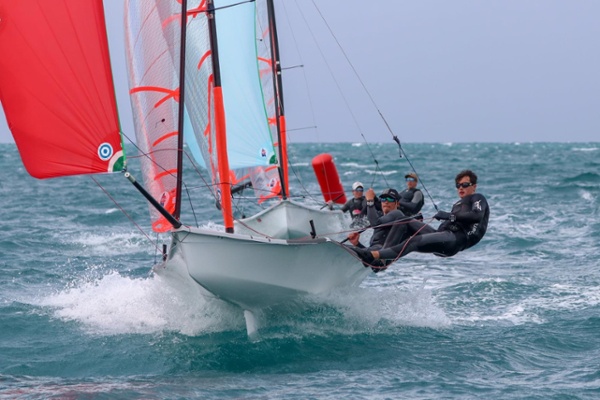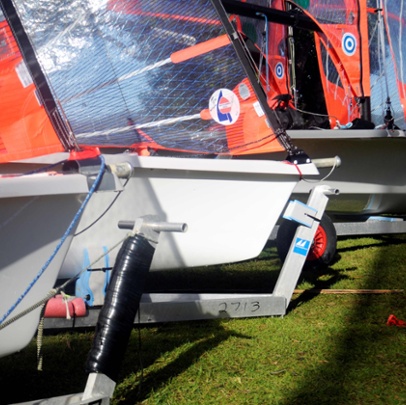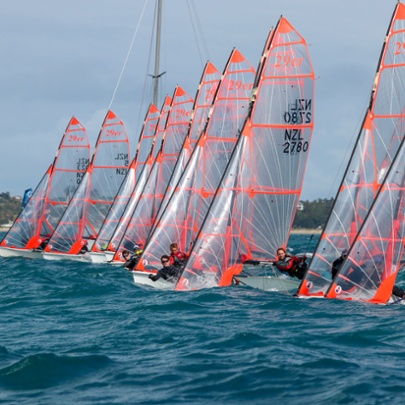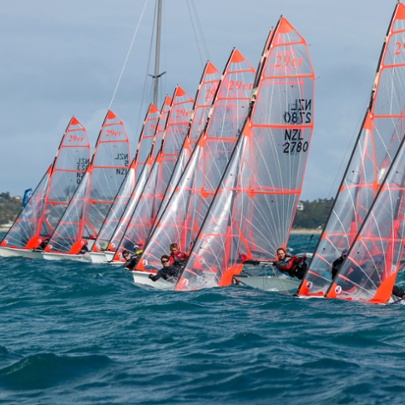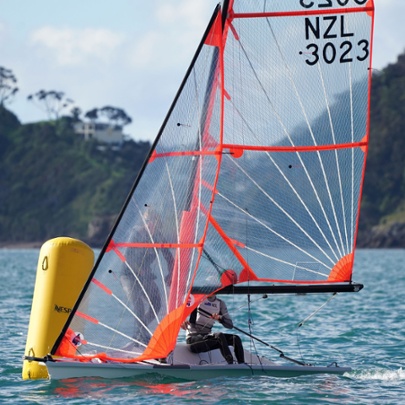The 29er
Lift off in a "flying machine" that transforms your sailing experience.
The 29er is a high-performance two-person, single trapeze skiff. With fully battened sails, a self-tacking jib and an asymmetric spinnaker, the Mackay built 29er provides a truly responsive, dynamic skiff experience.
The Specifications
Boat Weight 72-74 kg
Hull Length 4.4 m
Beam Length 1.7 m
No. of Crew 2
Number of Trapeze Single
Opt Crew Weight 120 - 140 kg
Hull Material GRP
Year Designed 1997
Spinnaker Area 16.83 m2
Sail Area (Upwind) 13.19 m2
Designer Julian Bethwaite
29er Class Association website: https://www.29er.org/
The Boat
The 29er was designed by Australian skiff legend Julian Bethwaite, with a team of internationally recognized dinghy sailors.
Although the design was originally targeted to youth sailors as a feeder class to the Olympic 49er, the 29er is a "super class" on its own merits. The optimal combined crew weight is considered to be 120 - 145kg's but is by no means limited to that span.
29ers are built to exceedingly strict one design standards, and under strict control of World Sailing. This assures that sailing ability is the key performance criterium.
The boats are rugged, well equipped and fully competitive straight out of the box. Failures are rare, sails are durable, and the expense of running the boat is modest.
The Hull
Constructed from hi-tech fibreglass-reinforced polyester in a foam sandwich layout, the hull is ultra-lightweight with a self-draining cockpit.
The Rig
The mast is in three parts - an aluminium bottom and middle section, with a polyester-fiberglass composite tip that gives the ultimate in gust response and acceleration.
Spars are made from CNC machined tubes.
The Sails
The 29er sails include a fully battened mainsail and self-tacking jib. Both mainsail and jib are made from a mylar transparent laminate. Add on an asymmetric spinnaker and you'll discover the 29er is pure dynamite downwind.
Other design features include a mainsail cuff to increase sail efficiency, a ram vang, safety foot/grab rails and an enclosed transom.
The Foils
Foils are made in CNC cut aluminium tooling.
Mackay built 29ers
Mackay built 29er hulls, foils and spars now available in New Zealand again.
With the Oceanic fleet sizes growing and new fleets in Asia and other Pacific rim countries, we recommenced production in 2020 using a full set of the latest moulds all made from CNC cut plugs.
Attention to detail is everything on our 29ers.
Small gel coat repairs are relatively easy to do.
What is Gelcoat made up of?
Gelcoat is a polyester product that is cured by using a catalyst called MEKP. (Methyl Ethyl Ketone Peroxide)
MEKP is a dangerous substance and should be treated as such when using, being very careful not to get any on your skin or in your eyes.
How can I get the catalyst - MERK?
We cannot ship MEKP so you will always need to buy it separately from your local marine store or fibreglass manufacturer.
How much MERK do I need?
The amount of Catalyst varies depending on the conditions you are using it in, but around 2%-3% will always work.
It is best to use a small syringe or dropper to get the required catalyst rate.
If you have mixed 100gm of gelcoat, then you are aiming for 2ml of catalyst.
What are the Gelcoat colours?
Gelcoats colours are not always a 100% perfect match.
Colour will vary depending on the depth of the repair and the batch.
470, 420, 29er & Starling are built from polyester resin.
For Polyester boats
470 White- LS30 White PA 337
470 Grey- Grey RAL 7035
Blue = is supplier by Nuplex who have their own code which is not an international code
Does Mackay Boats supply gelcoat?
We supply a small tin (of each relevant colour) with each new boat.
Order additional gelcoat from our store, although it cannot be shipped by courier.
How do I do gelcoat repairs?
Doing gelcoat repairs is an art that improves with experience.
Making sure the surface is prepared well and keyed up is critical.
Overfill and then sanding back is a slow and time-consuming process.
Be very careful not to scratch the boat around the repair.
You shouldn’t sand the original surface around the repair with any paper coarser than 600grit.
Mask around the repair to protect the boat.
You can initially use a file or 150g to take the high parts off the filling, but don't use the coarse paper for too long or you will end up with scratches in the finished repair.
Once you have it fair with 600g, you can work your way through the sandpaper grades until you finish with 1500grit before cutting and polishing.
We would typically use 600g, then 800g or 1000g, then 1200g, then finally 1500g.

